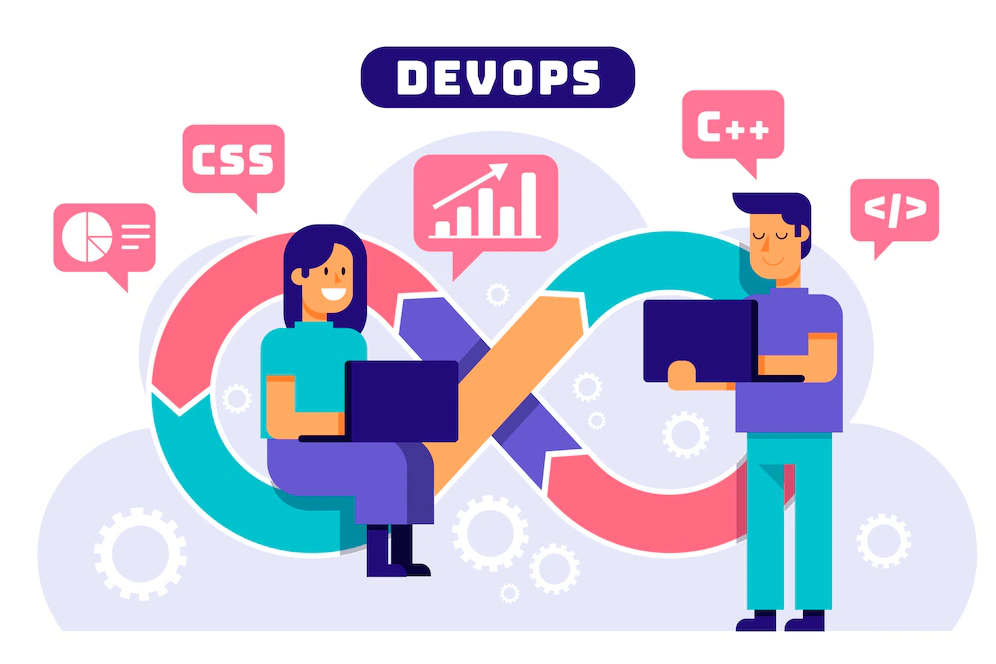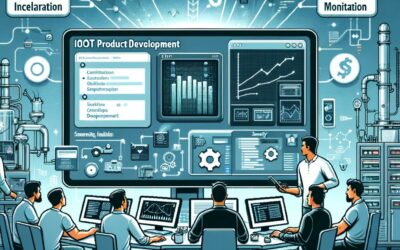DevOps Model
The DevOps model is a modern approach to software development and IT operations that emphasizes collaboration, automation, and continuous improvement. DevOps enables organizations to deliver software products faster and more frequently, with higher quality and lower risk. As a result, it will lead to increased efficiency, reduced downtime, and improved customer satisfaction. The DevOps model has proven to be highly effective for many organizations, helping them to stay ahead in an increasingly competitive marketplace. Whether you are a DevOps expert or a business enterprise, it is time to adopt this powerful approach and reap the benefits that it can bring.
What Is the DevOps Lifecycle?
The DevOps lifecycle is a continuous process of development and operations. It starts with identifying a need, followed by planning and development, testing, deployment, and finally, monitoring and continuous improvement. The key to success in the DevOps lifecycle is collaboration and communication between development and operations teams. Also, it involves automating processes and incorporating the feedback of all stakeholders as it ensures that software is always up-to-date and meets customer needs.
DevOps Best Practices
DevOps practices are the backbone of any successful DevOps transformation. By following these proven and tested methodologies, organizations can enjoy the benefits of faster deployment, increased collaboration, and improved customer satisfaction. It is time to embrace the DevOps best practices and revolutionize your software delivery process.
1. Agile Project Management
Agile Project Management is a game-changer in the world of DevOps. It is a flexible and adaptive approach to project management that emphasizes teamwork, collaboration, and communication. The focus is on delivering high-quality products on time. It is achieved by breaking down complex projects into smaller, manageable chunks.
Moreover, Agile methodology is a crucial practice that can help businesses to stay competitive and achieve their desired outcomes. To succeed in today’s fast-paced and ever-changing business environment, organizations must embrace Agile Project Management as one of their best DevOps practices.
2. Focus on Observability and Find the Right Metrics
DevOps best practices are based on receiving feedback and continuously improving the processes. Focusing on observability and finding the right metrics is one of the DevOps best practices for any business enterprise. This practice ensures that all systems, processes, and applications are operating at optimal performance levels.
Understanding the metrics relevant to the business is essential for identifying trends and making data-driven decisions. These metrics will differ from business to business and from team to team, depending on the goals and key results targeted. Moreover, finding the right metrics enables teams to measure their progress and determine key areas for improvement.
By focusing on observability, DevOps teams can quickly identify potential issues and bugs before they become significant problems. In short, the DevOps team must prioritize observability and find the right metrics to monitor, as it helps organizations identify problems quickly and make informed decisions.
3. Continuous Integration and Continuous Delivery
Frequent integration of small code chunks into a central repository enables seamless collaboration among developers. This approach keeps the repository stable as small modifications are easier to handle. Continuous Integration (CI) allows for the quick detection of errors and improves code quality through automated builds and tests with each change.
Once the code is integrated, the next step is to deploy it to the environment. Continuous Delivery (CD) streamlines this process by continuously making the code ready for deployment for every small change. This simplifies the deployment process and provides developers a convenient and automated way to push the updated code to production.
4. Learn From Incidents and Build Processes Around Them
Learning from incidents and building processes around them is essential for organizations that want long-term success. Incidents are opportunities to identify areas of improvement. By building processes around them, organizations can improve their efficiency, reduce the risk of future incidents, and improve the customer experience.
Furthermore, by analyzing the root cause of incidents and understanding the factors that led to their occurrence, we can identify potential areas for improvement and develop processes that prevent similar incidents from happening in the future. This proactive approach to process improvement ensures the continuity of our operations. Also, it enhances the reliability and resilience of the system.
5. Focus first on Concepts, then Find the Right Tools
This approach is crucial for DevOps experts and business enterprises to ensure the successful implementation of new technology and processes. By understanding the fundamental concepts and best practices, you can better evaluate the various tools available and choose the most appropriate one for your business needs.
Furthermore, a solid understanding of the concepts will allow you to effectively utilize the tools to achieve your goals and continuously improve processes. This approach also saves time and resources in the long run, as you won’t waste time and effort on tools that do not meet your requirements. Hence, before diving into tool selection, take the time to understand the concepts to set yourself up for success.
6. Monitor the DevOps Pipeline and Applications
In today’s fast-paced business environment, monitoring the DevOps pipeline and applications is no longer an option; it is a necessity. By investing in monitoring tools and techniques, businesses can ensure that their software delivery processes are efficient and secure and deliver value to customers. Also, it will help DevOps experts to detect and resolve any issues in the pipeline quickly. Additionally, monitoring allows for the early detection of potential security threats and performance bottlenecks. As a result, it will reduce the risk of data breaches and ensure the optimal performance of applications.
7. Foster a Culture of Collaboration and Blameless Communication
Promoting a culture of collaboration and blameless communication is the key element for the success of any organization. It means facilitating a work environment where everyone feels free to express their thoughts, opinions, and ideas without fear of judgment or retribution. By fostering an environment of collaboration, teams can work together to determine key areas of improvement and drive innovation. On the other hand, blameless communication encourages employees to speak up and share their concerns or ideas, as they are not afraid of being criticized or punished for their mistakes. As a result, it will lead to a more creative and innovative work environment where everyone feels valued and encouraged to contribute.
8. Implement Automation
Continuous integration and delivery (CI/CD) are crucial to effective DevOps practices. It automates the process of code integration into the central repository. With CI/CD, code is merged regularly rather than being manually checked. As a result, it will reduce the risk of errors in the code.
In addition, automated testing allows developers to validate the functionality and performance of their code with minimal manual intervention. Automated tests include end-to-end testing, unit testing, integration testing, and performance testing. Developers can quickly detect and resolve any issues by incorporating these tests into the DevOps CI/CD pipeline. Ultimately, it will lead to faster and more reliable software delivery.
9. Make a Move to Microservices
As businesses continue to grow, they face the challenge of managing complex systems and large amounts of data. As a result, the traditional monolithic approach to software development is no longer efficient and fails to meet the demands of modern businesses. This is where microservices come into play.
Microservices provide a more flexible and scalable solution to software development. It allows businesses to break down their systems into smaller, manageable components that can be developed, deployed, and updated independently. In addition, this approach assists the development team in responding quickly to changing market needs.
10. Embrace Infrastructure as Code (IaC) and Push for a Self-Service Infra Model
Incorporating cloud infrastructure into software development is one of the DevOps best practices. By using infrastructure as code, we can apply the same best practices used in software development, such as version control and continuous integration and deployment. It eliminates the requirement of manual setup and configuration of resources and reinforces the DevOps automation efforts across the IT domain. With this approach, changes are easily traceable and transparent. We can quickly revert the infrastructure systems to a previous state if any issue arises.
A self-service infrastructure model should be considered to further optimize the software development process. In this model, developers and anyone who needs infrastructure resources can use tools to generate the required components.
11. Continuous Security
Continuous security integrates security measures into the software development lifecycle, from development to deployment. This approach ensures that security is not just an afterthought but an important part of the development process. By incorporating security in the early stages of the development process, businesses can mitigate the risk of potential vulnerabilities and attacks and reduce remediation costs. Continuous security is one of the best DevOps practices that leads to more secure software and a safer business enterprise.
Conclusion
Implementing best practices has proven to be a game changer for businesses across various industries. These practices enable organizations to achieve continuous delivery and deployment, improve collaboration between development and operations teams, and enhance the overall software delivery process. By adopting DevOps best practices, businesses can not only speed up their delivery cycles but also reduce downtime, improve customer satisfaction, and gain a competitive advantage.
FAQ
What is DevOps Best Practice?
Some of the DevOps best practices include:
- Automate everything
- Collaboration between the development team and operations team
- Continuous integration and delivery
- Continuous performance monitoring
- Configuration management
- Test-driven development
- Security
- Use version control
What are the Three Pillars of DevOps?
The three pillars of DevOps are:
- Culture: It refers to the values, beliefs, and practices guiding the development and operations teams.
- Automation: It involves using technology and tools to automate the various stages of the development and delivery process.
- Measurement: It includes collecting and analyzing data to measure the performance of the development team and operations teams.




